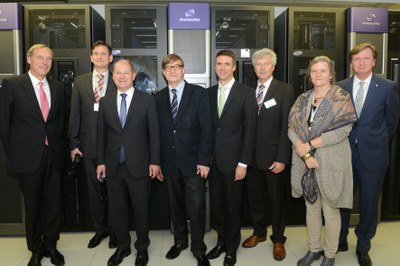 41 racks, each the size of a telephone box and weighing up to a metric ton, house the new supercomputer named “Mistral”. When thinking about the typical size of a standard PC, one can imagine what level of performance such a system in this dimension may have. In its final stage of expansion, which will be completed in summer 2016, Mistral will be 20 times faster than its predecessor although its energy consumption will remain the same. Its processing power will then more than double from 1.4 to 3 PetaFLOPS, that is 3 quadrillion floating point operations per second. Theoretically, this translates to the approximate total performance of 100,000 notebooks. The storage capacity integrated into the system is larger than 20 Petabytes today and will even increase to 50 Petabytes in 2016 – about the same amount of space required to store ten million feature films. In this way, DKRZ is committed to adapting to the increasing requirements of its users, allowing for more detailed and statistically more reliable climate simulations. Thus, more and more important processes in the atmosphere, the ocean and the biosphere can be taken into account and understood.
41 racks, each the size of a telephone box and weighing up to a metric ton, house the new supercomputer named “Mistral”. When thinking about the typical size of a standard PC, one can imagine what level of performance such a system in this dimension may have. In its final stage of expansion, which will be completed in summer 2016, Mistral will be 20 times faster than its predecessor although its energy consumption will remain the same. Its processing power will then more than double from 1.4 to 3 PetaFLOPS, that is 3 quadrillion floating point operations per second. Theoretically, this translates to the approximate total performance of 100,000 notebooks. The storage capacity integrated into the system is larger than 20 Petabytes today and will even increase to 50 Petabytes in 2016 – about the same amount of space required to store ten million feature films. In this way, DKRZ is committed to adapting to the increasing requirements of its users, allowing for more detailed and statistically more reliable climate simulations. Thus, more and more important processes in the atmosphere, the ocean and the biosphere can be taken into account and understood.
How then is climate simulated? In climate modeling, atmosphere and ocean are subdivided into numerous grid cells. For each of these cells and based on initial values for the physical variables, complex physical equation systems are solved in order to get new values for a point later in time. These are then used as new starting values, and the computation is repeated once again from the beginning to calculate a point further into the future. The finer the grid, the shorter the time increment has to be, which means that even more computations are needed for the same time period simulated. So, for example, doubling the resolution would lead to about 10 times the number of calculations.
Regional models of Germany, for example, were only possible with a grid resolution of 10 km or more. In contrast, the new supercomputer Mistral enables the simulation of the same area with a resolution of 100 m. With such a high resolution model, small scale processes such as the formation of clouds can be directly simulated, now making much more detailed regional climate simulations possible. Regional phenomena including heavy precipitation events can be simulated. In this way, Mistral allows us to better face one of the biggest challenges in climate research: the complexity and dynamics of our climate.
Beyond that, DKRZ plays an important role in collecting and redistributing climate model data for scientists all over the planet. Its huge tape-based archive system is currently comprised of more than 20 million files with a total size of about 40 Petabytes. Numerous studies and publications are being made based on the data delivered by DKRZ, which, for example, contribute to the IPCC assessment reports. The results of the climate projections carried out, for example, also support the German Federal Government with respect to the upcoming negotiations at the COP21 conference in Paris.
 Total investment costs for the new system are on the order of 41 million Euros, 2/3 of which are funded by the German Ministry for Education and Research (BMBF) and 1/3 by the Helmholtz Association (HGF). The new supercomputer was built by the French Company Atos/Bull.
Total investment costs for the new system are on the order of 41 million Euros, 2/3 of which are funded by the German Ministry for Education and Research (BMBF) and 1/3 by the Helmholtz Association (HGF). The new supercomputer was built by the French Company Atos/Bull.
Press release as pdf-file
